This week the Wednesday Comics Reviews team tackles a real grab bag, including the creator jam Ice Cream Man #43, the start of a new story arc in Teenage Mutant Ninja Turtles, a fresh take on Jack The Ripper comics with Ripperland #1, and more! Warning: there may be spoilers.
Are you a weekly comics sicko? You’ve come to the right place. This is where The Beat’s review team writes about the new #1s, finales, and other notable issues out in shops from non-Big 2 publishers…enjoy!
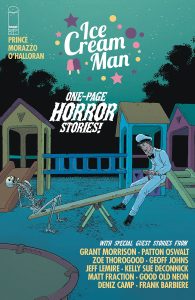 Ice Cream Man #43
Ice Cream Man #43
Writers: W. Maxwell Prince, Grant Morrison, Matt Fraction, Kelly Sue Deconnick, Geoff Johns, Deniz Camp, Zoe Thorogood, Patton Oswalt, Jeff Lemire, and Frank Barbiere
Artist: Martin Morazzo, with a page by Zoe Thorogood
Colorist: Chris O’Halloran
Letterer: Good Old Neon
Publisher: Image Comics
Review by Sean Dillon
In serialized comics, there’s nothing harder than the act of working with a single page. Most comics writers (at least, the ones working outside of the newspapers) are working with roughly 22-28 pages an issue. One has to work with the full spectrum of the space provided rather than having the benefit of working with an additional number of pages to expand and elaborate upon ideas. And as such, one might not be used to working with the limitations.
There are some examples of the single page format within modern serialized comics. DC Comics, back in the early 2000s, did a series inspired by the old newspaper strips called Wednesday Comics, which had a wide variety of brilliant creators doing some of their best work. John Lees’ Sink frequently includes one-page backups by different creative teams to flesh out the world of Sinkhill.
As such, when reading an anthology of one page stories, it’s interesting to see how the creators deal with these limitations, especially within the context of Ice Cream Man. Unlike Sink, whose horror often involves a lot of blood, guts, and violence, the horror of Ice Cream Man relies on the existential dread that all of existence is pointless and will only result in cruelty and horror. Elliptical in nature, often ending with a lack of answers and a sense of unease rather than a straightforward punchline of, say, a little girl holding the hand of a bloody, axe wielding Santa with murder in his eyes as the girl’s mother looks on in horror. (Admittedly, the premise has run a bit thin over the past 43 issues of yours truly due to feeling like it’s making the same point over and over again. But I was nevertheless curious to see what a new batch of creators would do with the material.)
As such, one of the most obvious approaches taken within this anthology is to utilize a grid. Of the 22 stories included in this anthology, half of them utilize some form of grid, most commonly either the nine-panel grid or six rows of single panels. While this is an obvious approach to the single page (as a grid allows for a structure to form that creates a beat for the writer to focus on [tellingly, ten of the eleven stories using a grid use the entire grid rather than combining panels]), this by no means implies this to be a bad approach. One of the best stories within the anthology, Deniz Camp’s “Real Page-Turner,” uses a nine panel grid to build to its rather straightforward punchline involving a man reading a comic. (Camp previously wrote for Ice Cream Man in its Quarantine Comix Special with the truly excellent “Mene, Mene, Tekel, Upharsin.”) Equally, Kelly Sue DeConnick’s “Missy in the Middle” alternates between silent panels and narration to an effectively unsettling result.
But that doesn’t necessarily make the girds work well. Geoff Johns’ “Lickety Split,” for example, overutilizes the dialogue of its central character, Chef Gary, to an unbearable degree, not helped by the claustrophobic effect of using a sixteen panel grid. And Zoe Thorogood’s “For James” (one of five stories not drawn by Martín Morazzo, instead by Thorogood herself) would’ve been improved immensely if the ending was a singular panel rather than separated into thirds to emphasize the haunting presence of James.
Alternatively, one can upend the structure of the comics page. Reject comics entirely in favor of prose or some other medium. Indeed, three of the stories within the anthology do just that. In this anthology, however, the results have been rather mixed. Good Old Neon’s “A Taxonomy of Old-Timey Diseases” is a rather straightforward bubble chart listing a number of names for diseases in times gone by that makes you wish Jonathan Hickman was involved in this issue. Ice Cream Man creator W Maxwell Prince’s “For Sale (Unabridged)” is a rather rambling meander about that doesn’t really amount to much.
But the most notable of these is another Prince contribution (he wrote eleven of the stories), “Horror, Cont’d.” Rather straightforwardly, it’s the front page of the November 7th, 2024 edition of The New York Times with the caption “Sometimes the sequel is much scarier than the first one.” underneath the image of Donald Trump raising his fist in the air in victory. To be blunt, this is the failure state of Ice Cream Man in a nutshell. A rather unsubtle slap in the face without any real commentary about the world so much as poking at things with a stick and going “Gee, isn’t this fucked up?”
The elliptical nature that can work to a startling degree can likewise result in wet farts. It relies primarily on the atmosphere that builds to the conclusion. What is the vibe of the comic you are reading? You have to build to the discomforting conclusion rather than assume that being horror fiction is enough.
The most obvious of these is Prince’s “Who’s in Charge?” Clearly riffing on ideas within Grant Morrison and Doug Mahnke’s Ultra Comics (Morrison being a major influence on Ice Cream Man, having multiple issues riffing on their comics and Morrison themselves being a contributor to this anthology), we have another nine panel grid comic of the titular Ice Cream Man telling the reader to do things, thereby proving he has power over the reader.
Except… this is rather passe. In Ultra Comics, we had a looming sense of tension and dread, as well as other ideas to go alongside the rather basic idea of “Ideas control us.” Furthermore, there was more going on than just a single page of the same character against a plain vanilla background and didn’t act as if the ending punchline was worthwhile. It doesn’t unsettle the way it should. There’s no build up to the punchline. Indeed, a lot of elements work against such a buildup. For example, the big punchline is clearly when the Ice Cream Man says “…But I have total control over you…” such that letterer Good Old Neon opts to use spooky black word balloons with white crooked text. Which could work, except they previously used that font in the third panel of the story, wherein the Ice Cream Man tells us “Look behind you.” None of the other orders he gives the reader are written like this, but it results in the punchline being defanged of any effect.
Ultimately, much like the series it spawned from, this anthology issue is largely fine, but not as earth-shattering as one would hope.
That said, the one with the kitten was truly hilarious.

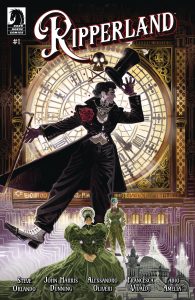 Ripperland #1
Ripperland #1
Writers: Steve Orlando and John Harris Dunning
Art: Alessandro Oliveri
Colors: Francesca Vivaldi
Letters: Fabio Amelia
Publisher: Dark Horse Comics
Review by Clyde Hall
An interesting if unlikely premise can still fire the imagination with its four-alarm level of potential. And that’s the kind of story Steve Orlando and John Harris Dunning have cooked up in Ripperland. Welcome to London, 2188. The UK has split apart, and England is a protectorate of the United States. They had little to offer in exchange for military and economic protection, but what England did have was history and location.
Speaking to those strengths, it was agreed that England would resume the living conditions, fashion, and technology of the Victorian era. Think of it as enforced historical reenactment for a theme park setting, one that has developed into the number one vacation destination for rich Americans. The tourists pay well for a completely immersive experience that they participate in and take full pleasurable advantage of.
It’s one of these monied and influentially connected visitors who falls prey to a murderer who not only lives in a London mimicking the era of Jack the Ripper. The grisly manner of murder most foul is also reenactment, performed in the distinctive style of Saucy Jack.
Given the victim’s VIP stature, FBI Agent Jesse Holden is brought in to work the case along with Scotland Yard Detective Edwin Fogg. In 2025 terms, that would be like saddling a bonded Federal investigator with a warden of the City Watch at a Ren Faire. Fogg is bound by the rules enforced by the U.S. and is relegated to 19th Century tech in his investigative duties. Holden thinks he’s above rules until it’s made clear that openly standing apart from the Victorian timeline is markedly unhelpful on almost every level.
Breaking the illusion is bad for tourism and draws complaints from the very U.S. citizenry Holden’s there to serve. If your town was forced to live as it had 300 years ago, without indoor plumbing, electricity, and the internet, and someone who enforces that rule showed up to conduct an investigation but refused to ‘take part’, how cooperative might you be? Or would this be your chance to show a pampered, entitled technocrat what life on the other side of the tech tracks is like?
This is where Orlando and Dunning draw the reader in, and not only with a murder mystery but also with the “What about…” Since the gin-soaked alleys of the West End are once more littered with open prostitution and human refuse real-life-as-cosplay, how far has the tech ban gone? Does it include medicines and health treatments? Is syphilis rampant, but only the tourists from America able to get it treated and cured once they return home? Horse-drawn carriages and outhouses make for an entirely unique aromatic experience when it comes to urban living, not to mention the butcher’s markets with hanging cuts of poultry, pork, and beef on display. What kind of health code provisions are made or even allowed?
In short, how far does the accuracy extend and for who? What about anyone refusing to play along? Were residents so desperate, so thankful for the investment back into their economy, that they willingly agreed and continue complying lest the bad times return? Regardless, there comes a sadness in the storyline contention that future generations could completely forego time travel or Westworld level animatronics. Instead, they can simply lord economic dominance over a suffering population and replace their everyday lives with reenacting the distant past as obedient droids willing to serve any whim.
The stomping grounds of 1880s London have been visited in comics pages and movie screens a lot, not to mention in early location/crime scene photos of the Ripper era. Alessandro Oliveri works great detail into the panel backgrounds lending the tale a sense of authenticity. He balances that against a nearly equal number of panels with no background, and it’s a blend that works. The give-and-take is assisted by richly rendered period attire for many characters in the foreground of those plainer panels.
The Francesca Vivaldi colors add shadowy back alleys without overdosing on the inky, and that requires tasteful restraint. Even the American scenes in the FBI offices have a backroom seediness in their hues, contrasting the Victorian London locations yet perfectly matching their tone. Dirty deeds seen through a dirtier, very human lens while serenaded by the howls of their better devils.
All that, and in the wake of Ripperland #1 we’re left with many mysteries besides the obligatory whodunnit. I want to know about specific details regarding the conditions of protectorate, a possible political motivation behind the murder, and the fall from grace which earned Agent Holden this hotplate of an assignment. These are all things readers can look forward to in the next issues while also enjoying a Jack the Ripper tale that’s truly distinctive from so many others. A nation-sized theme park forcibly reliving a period of vice, virtue, and industrialization may strain bounds of plausibility, but it makes up for that with intriguing possibilities.

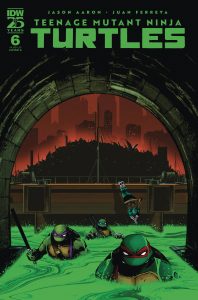 Teenage Mutant Ninja Turtles #6
Teenage Mutant Ninja Turtles #6
Writer: Jason Aaron
Artist: Juan Ferreyra
Letterer: Shawn Lee
Designer: Nathan Widick
Publisher: IDW Publishing
Review by Zee
Teenage Mutant Ninja Turtles #6 finally brings the heroes in a half shell to Manhattan, after four issues dedicated to catching us up with them in various parts of the world, and one from the perspective of Casey Jones to show us what has happened to the city of New York while they’ve been gone.
While the past five issues have been effectively the ‘prelude’, #6 is where things actually start to kick into high gear. Tensions are as high as ever between the four brothers, and you can really feel that tension in every interaction between them. That desperate feeling of wanting to return to what once was, trying to bring that moment back, yet unable to because things have changed so much, and that exact feeling is why this run has been working so far, while under a less skilled pen it would just turn out to feel like an edgy take on the Ninja Turtles.
Jason Aaron continues to bring his A-Game to this, in the same way he’s doing for Absolute Superman over at DC Comics, without making them feel like the same, even as they’re both playing with the same theme – the loss, and subsequent want, of home. Even as issue 6 feels like where the ‘real story starts’, and in some ways it feels like a jumping on point, but Aaron continues to build on threads set up in the previous 5, as well as the ‘Alpha’. The only gripe that remains is the way that they’re teasing why the Turtles split up. It’s obviously building up to something, but the way it continues to be brought up feels more akin to a mystery box meant to simply string us along than provide meaningful answers. I just hope I’m proven wrong sooner rather than later.
Alongside him of course is Juan Ferreyra, the series’ ongoing artist. While it was cool to have all these different artists provide their own takes on each of the Turtles, and later Casey, it’s great to have an artist unite all of this together in one cohesive vision, and Ferreyra does not disappoint. Expressive faces and body language really sell Aaron’s dialogue, coupled with some extremely kinetic compositions which live up to the ‘superstar’ moniker stated in the solicit for the issue. His use of shadows is what comes off the most striking to me. I’m constantly enamored by how much they add to every single page, and I cannot wait to see what comes next from him in this book.
I really dug Teenage Mutant Ninja Turtles #6. When I initially read #1 back when it came out, it didn’t really speak to me. But reading it all in one go and seeing it come together sold me on the vision Aaron has for our half-shelled heroes. It’s interesting enough to keep me hooked, especially with that fantastic art, but I hope that we start getting some answers as opposed to simply asking questions, because that one gripe is coming close to waning my interest in the title.
Rapid Wednesday Comics Reviews
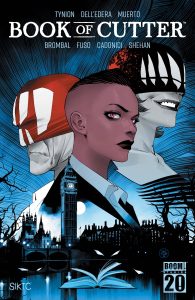 Book of Cutter #1 (BOOM! Studios): Book of Cutter is a one-shot and lore dump of sorts, setting the stage for Maxine’s personal growth and movement within the Something is Killing the Children (SIKTC) series. I have not read nearly enough of SIKTC to have felt up to speed, but I do understand colonialism and political power/control and that angle was intriguing to me.
Book of Cutter #1 (BOOM! Studios): Book of Cutter is a one-shot and lore dump of sorts, setting the stage for Maxine’s personal growth and movement within the Something is Killing the Children (SIKTC) series. I have not read nearly enough of SIKTC to have felt up to speed, but I do understand colonialism and political power/control and that angle was intriguing to me. As a one-shot within the larger story, you’re given history around the House of Cutter and the draw is predicated on your investment in the SIKTC series and world because it is dense with history, building out this world and how the houses came to be. A little under half of the one-shot delivers this lore through prose pages and journal entries written by Tate Brombal, weaving a tale of historical fiction and colonialism, from the medieval era to the attempted colonial conquest of Asia and the successful colonization of America. This is juxtaposed in comic pages as James Tynion IV writes Maxine’s journey overseas, training and learning more of the mechanisms of the houses and how this shadowy organization has entwined itself in the workings of the world and how it is structured. It’s a slower read that doesn’t have a ton of action however is full of well constructed conversations and exchanges of information illustrated by Werther Dell’Edera, Antonio Fuso, Letizia Cadonici and Chris Shehan with colors by Miquel Muerto and letters by AndWorld Design. The issue looks good and is thoughtful, but if you’re not privy to what’s happening in SIKTC it might be harder to recommend. —Khalid Johnson
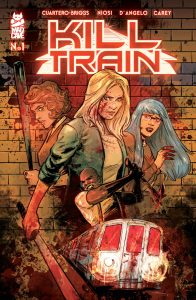 Kill Train #1 (Mad Cave Studios): In the face of what can only be described as a likely repeat failure in city management against the obvious choice of legislation, the best the city government of New York could come up with to solve a population boom was to make the subway even less enjoyable by turning random trips into the titular Kill Train. Written by Olivia Cuartero-Briggs, the story told is one of a woman trying to find her identity and independence in a world completely ignorant of her existence and needs. With art and colors by Martina Niosi and Simone D’Angelo, respectively, we can see just how rough the character of Vanessa has it. The facial acting Niosi puts on the page gives that same sense of stress and dread to readers as Vanessa directly experiences it, with D’Angelo’s colors bringing the vivid and violent world to life. Letters by Becca Carey bring it on home with interesting internal monologue/that voice in your head telling you that you can’t do something. It all makes for somewhat too real of a read when it comes to capturing how the mind can work in the face of what feels like never-ending stress and self-doubt. —Bryan Reheil
Kill Train #1 (Mad Cave Studios): In the face of what can only be described as a likely repeat failure in city management against the obvious choice of legislation, the best the city government of New York could come up with to solve a population boom was to make the subway even less enjoyable by turning random trips into the titular Kill Train. Written by Olivia Cuartero-Briggs, the story told is one of a woman trying to find her identity and independence in a world completely ignorant of her existence and needs. With art and colors by Martina Niosi and Simone D’Angelo, respectively, we can see just how rough the character of Vanessa has it. The facial acting Niosi puts on the page gives that same sense of stress and dread to readers as Vanessa directly experiences it, with D’Angelo’s colors bringing the vivid and violent world to life. Letters by Becca Carey bring it on home with interesting internal monologue/that voice in your head telling you that you can’t do something. It all makes for somewhat too real of a read when it comes to capturing how the mind can work in the face of what feels like never-ending stress and self-doubt. —Bryan Reheil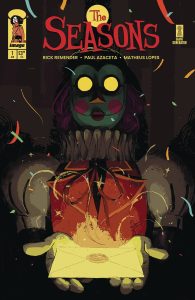 The Seasons #1 (Image Comics / Giant Generator): This book was one of my most-anticipated of the early year, coming from writer Rick Remender, artist Paul Azaceta, colorist Matheus Lopes, and letterer Rus Wooton. I think I’d best describe the genre here as “scary fantasy circus.” Although the first issue is structured as more of a pair of introductory teases, bookending a slapstick chase story. And you know, it’s a really fun way to be introduced into this new world. The gags are decent, nothing too funny, but the kinetic artwork and endearing character moments are both really great. The aesthetic of this book — which lets Azaceta oscillate from threatening to whimsical, very naturally — is just excellent. Overall this is a good-looking and fun first issue that does an effective job teasing what this series is going to ultimately be about. I find myself thoroughly enticed. —Zack Quaintance
The Seasons #1 (Image Comics / Giant Generator): This book was one of my most-anticipated of the early year, coming from writer Rick Remender, artist Paul Azaceta, colorist Matheus Lopes, and letterer Rus Wooton. I think I’d best describe the genre here as “scary fantasy circus.” Although the first issue is structured as more of a pair of introductory teases, bookending a slapstick chase story. And you know, it’s a really fun way to be introduced into this new world. The gags are decent, nothing too funny, but the kinetic artwork and endearing character moments are both really great. The aesthetic of this book — which lets Azaceta oscillate from threatening to whimsical, very naturally — is just excellent. Overall this is a good-looking and fun first issue that does an effective job teasing what this series is going to ultimately be about. I find myself thoroughly enticed. —Zack Quaintance
The Prog Report
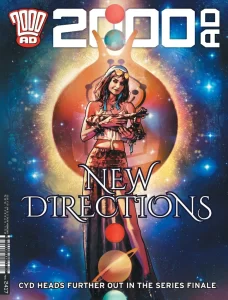 2000AD 2417 (Rebellion): The current Hawk The Slayer story, The Last of Her Kind, has really been a slow build — and now the action has erupted. This week’s fifth part of the story is non-stop fantasy action, basically start to finish. I thought it was great, picking up right on the tense note right last week’s strip, before barreling through to a fantastic cliffhanger ending. I’ve really been enjoying this story, and I found this week’s action more engaging for the build that came before it. Hawk the Slayer: The Last of Her Kind is by writer Alec Worley, artist Simon Coley, colorist Gary Caldwell, and letterer Annie Parkhouse. Meanwhile, this week marks the end of the current book of The Out, by writer Dan Abnett, artist Mark Harrison, and letterer Simon Bowland. I’ve lightly followed this one, being unfamiliar with the preceding books, and I’ve liked it so much (particularly the artwork), it’s motivated me to go back and catch up on all that came before. Finally, stay calm…but apparently Judge Dredd has a dog friend now? We get to meet this very good boy in a story called Judge Dredd: A Dog’s Life by writer Mike Carroll, artist Nicolo Assirelli, colorist John Charles, and letterer Annie Parkhouse. This week’s cover (above) is by Mark Harrison. As always, you can pick up a digital copy of The Prog here. —Zack Quaintance
2000AD 2417 (Rebellion): The current Hawk The Slayer story, The Last of Her Kind, has really been a slow build — and now the action has erupted. This week’s fifth part of the story is non-stop fantasy action, basically start to finish. I thought it was great, picking up right on the tense note right last week’s strip, before barreling through to a fantastic cliffhanger ending. I’ve really been enjoying this story, and I found this week’s action more engaging for the build that came before it. Hawk the Slayer: The Last of Her Kind is by writer Alec Worley, artist Simon Coley, colorist Gary Caldwell, and letterer Annie Parkhouse. Meanwhile, this week marks the end of the current book of The Out, by writer Dan Abnett, artist Mark Harrison, and letterer Simon Bowland. I’ve lightly followed this one, being unfamiliar with the preceding books, and I’ve liked it so much (particularly the artwork), it’s motivated me to go back and catch up on all that came before. Finally, stay calm…but apparently Judge Dredd has a dog friend now? We get to meet this very good boy in a story called Judge Dredd: A Dog’s Life by writer Mike Carroll, artist Nicolo Assirelli, colorist John Charles, and letterer Annie Parkhouse. This week’s cover (above) is by Mark Harrison. As always, you can pick up a digital copy of The Prog here. —Zack Quaintance
Read more entries in the weekly Wednesday Comics reviews series!
A new Hellboy Universe series kicks off with Frankenstein: New World – The Sea of Forever #1, there’s another between-arcs issue with Kaya #25, and more
Source link

 Ice Cream Man #43
Ice Cream Man #43




